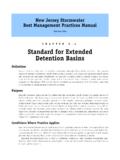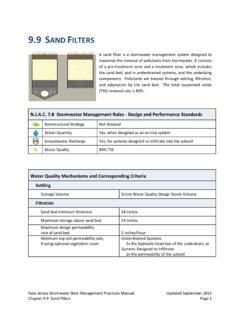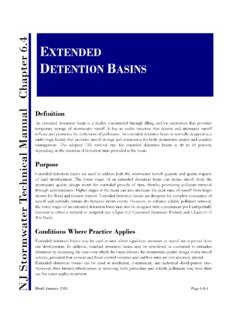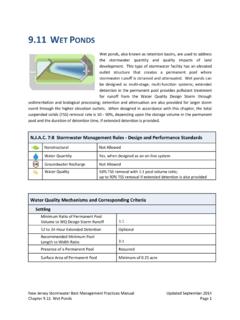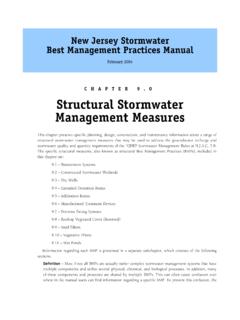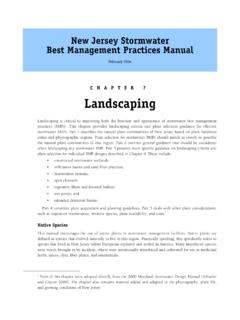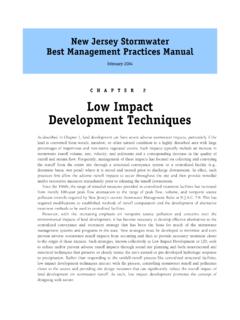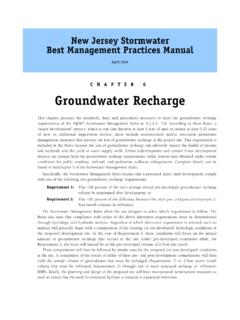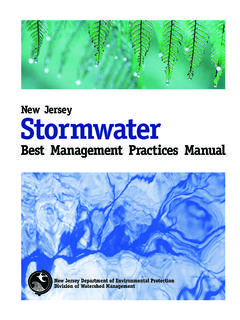Transcription of CHAPTER 9.3 Standard for Dry Wells - NJ Stormwater.org
1 New jersey StormwaterBest Management Practices ManualFebruary 2004 CHAPTER for Dry WellsDefinitionA dry well is a subsurface storage facility that receives and temporarily stores stormwater runoff from roofsof structures. Discharge of this stored runoff from a dry well occurs through infiltration into thesurrounding soils. A dry well may be either a structural chamber and/or an excavated pit filled withaggregate. Due to the relatively low level of expected pollutants in roof runoff, a dry well cannot be used todirectly comply with the suspended solids and nutrient removal requirements contained in the NJDEPS tormwater Management Rules at 7:8.
2 However, due to its storage capacity, a dry well may be usedto reduce the total stormwater quality design storm runoff volume that a roof would ordinarily discharge todownstream stormwater management Wells can be used to reduce the increased volume of stormwater runoff caused by roofs of generally not a significant source of runoff pollution, roofs are one of the most important sources ofnew or increased runoff volume from land development sites. Dry Wells can also be used to indirectlyenhance water quality by reducing the amount of stormwater quality design storm runoff volume to betreated by the other, downstream stormwater management Wells can also be used to meet the groundwater recharge requirements of the NJDEP StormwaterManagement Rules.
3 See Recharge BMP Design Guidelines in CHAPTER 6: Groundwater Recharge for a completediscussion of these requirements and the use of dry Wells and other groundwater recharge facilities to Where Practice AppliesThe use of dry Wells is applicable only where their subgrade soils have the required permeability soil permeability requirements are presented below in Design other BMPs that rely on infiltration, dry Wells are not appropriate for areas where high pollutant orsediment loading is anticipated due to the potential for groundwater contamination.
4 Specifically, dry wellsmust not be used in the following locations: Industrial and commercial areas where solvents and/or petroleum products are loaded, unloaded,stored, or applied; or pesticides are loaded, unloaded, or jersey stormwater Best Management Practices Manual CHAPTER : Standard for Dry Wells February 2004 Page Areas where hazardous materials are expected to be present in greater than reportable quantities as defined by the Environmental Protection Agency in the Code of Federal Regulations at 40 CFR Areas where dry well use would be inconsistent with an NJDEP-approved remedial action workplan or landfill closure plan.
5 Areas with high risks for spills of toxic materials such as gas stations and vehicle maintenancefacilities. Areas where industrial stormwater runoff is exposed to source material. Source material meansany material(s) or machinery, located at an industrial facility, that is directly or indirectly relatedto process, manufacturing or other industrial activities, that could be a source of pollutants in anyindustrial stormwater discharge to groundwater. Source materials include, but are not limited toraw materials, intermediate products, final products, waste materials, by-products, industrialmachinery and fuels, and lubricants, solvents, and detergents that are related to process,manufacturing, or other industrial activities that are exposed to addition, as required by the NJDEP stormwater Management Rules, dry Wells must not be used wheretheir installation would create a significant risk for basement seepage or flooding, cause surficial flooding ofgroundwater.
6 Or interfere with the operation of subsurface sewage disposal systems and other subsurfacestructures. Such adverse impacts must be assessed and avoided by the design Wells must be located and configured where their construction will not compact the soils below the drywell. Finally, a dry well must have a maintenance plan and, if privately owned, should be protected byeasement, deed restriction, ordinance, or other legal measures that prevent its neglect, adverse alteration,and : Dry well ComponentsSource: Adapted from standards for SoilErosion and Sediment Control in New JerseyNew jersey stormwater Best Management Practices Manual CHAPTER .
7 Standard for Dry Wells February 2004 Page CriteriaThe basic design parameters for a dry well are its storage volume and the permeability rate of the subgradesoils. A dry well must have sufficient storage volume to contain the design runoff volume without overflow,while the subgrade soils permeability rate must be sufficient to drain the stored runoff within 72 of these and other design parameters are presented below. The components of a typical dry well areshown above in Figure Storage Volume, Depth, and DurationA dry well must be designed to treat the total runoff volume generated by the dry well s maximum designstorm.
8 This may either be the groundwater recharge or stormwater quality design storm, depending uponthe dry well s proposed use. Techniques to compute these volumes are discussed in CHAPTER 6: GroundwaterRecharge and CHAPTER 5: Computing stormwater Runoff Rates and Volumes. A dry well must also fully drain thisrunoff volume within 72 hours. Runoff storage for greater times can render the dry well ineffective and mayresult in anaerobic conditions, odor, and both water quality and mosquito breeding problems. The bottomof the dry well must be at least 2 feet above seasonal high water table or bedrock and be as level as possibleto uniformly distribute runoff infiltration over the subgrade discussed in Considerations below, construction of a dry well must be done without compacting thedry well s subgrade soils.
9 As such, all excavation must be performed by equipment placed outside the drywell whenever possible. This requirement should be considered when designing the dimensions and totalstorage volume of a dry is important to note that the use of dry Wells is recommended in this manual only for the stormwaterquality design storm and smaller storm events. Use of dry Wells for larger storm events and the requirementsby which such dry Wells are to be designed, constructed, and maintained should be reviewed and approvedby all applicable reviewing Permeability RatesThe minimum design permeability rate of the subgrade soils below a dry well will depend upon the drywell s location and maximum design storm.
10 The use of dry Wells for stormwater quality or quantity controlis feasible only where the soils are sufficiently permeable to allow a reasonable rate of infiltration. Therefore,dry Wells designed for storms greater than the groundwater recharge storm can be constructed only in areaswith Hydrologic Soil Group A and B soils. Additional permeability requirements are presented below inTable : Minimum Design Permeability Rates for Dry WellsMaximum Design StormMinimum Design PermeabilityRate (Inches/Hour)Groundwater Recharge* *See text for required diversion of runoff from greater jersey stormwater Best Management Practices Manual CHAPTER .
